NCERT Solutions for Class 10 Maths Chapter 6 Triangles- The team of subject matter experts at GFG have given detailed NCERT Solutions for Class 10 Maths Chapter 6 Triangles in this article to make sure that every student can understand how to solve Triangle problems in a stepwise manner.
Class 10 Maths Chapter 6 Triangles provides in-depth information about triangles along with the ideas of similarity and congruence of triangles and associated theorems such as Pythagoras Theorem and Thales Theorem.
|
|
|
- NCERT Solutions for Class 10 Maths Chapter 6 Triangles Exercise 6.3 Set 1, Set 2 – 16 Questions (12 Short Answers, 4 Long Answers)
|
|
- NCERT Solutions for Class 10 Maths Chapter 6 Triangles Exercise 6.5 Set 1, Set 2 – 17 Questions (15 Short Answers, 2 Long Answers)
|
|
This article provides solutions to all the problems asked in Class 10 Maths Chapter 6 Triangles of your NCERT textbook in a step-by-step manner as per the latest CBSE Syllabus 2023-24 and guidelines. They are regularly revised to check errors and updated according to the latest CBSE Syllabus 2023-24 and guidelines.
NCERT Solutions for Class 10 Maths Chapter 6 Triangles: Exercise 6.1
Question 1. Fill in the blanks by using the correct word given in brackets.
(i) All circles are ……………. . (congruent/similar)
Solution:
All circles are similar because they have radius in fixed proportion.
(ii) All squares are …………… . (similar/congruent)
Solution:
All squares are similar because the ratio of corresponding sides are equal.
(iii) All …………….. triangles are similar. (isosceles/equilateral)
Solution:
All Equilateral triangles are similar because the ratio of corresponding sides are equal.
(iv) Two polygons of the same number of sides are similar, if (a) their corresponding angles are …………… and (b) their corresponding sides are …………… (equal/proportional)
Solution:
Two polygons of the same number of sides are similar, if (a) their corresponding angles are equal and (b) their corresponding sides are proportional.
Question 2. Give two different examples of pair of
(i) similar figures. (ii) non-similar figures.
Solution:
(i) Similar figures.
- All rectangular boards are similar
- All circular rings are similar
(ii) Non-similar figures
- A notebook and a pen are non-similar
- A rectangle and a circle are non-similar.
Question 3. State whether the following quadrilaterals are similar or not:

Solution:
Both the figures are non-similar. For similarity, the corresponding angles should be equal and corresponding sides are in the same ratio. But in this figure ratio of corresponding sides (AB/PQ = AS/PS = DC/SR = CB/RQ = 3/1.5 = 2) but corresponding angles are not equal.
NCERT Solutions for Class 10 Maths Chapter 6 Triangles: Exercise 6.2
Theorem 6.1 :
If a line is drawn parallel to one side of a triangle to intersect the other two sides in distinct points, the other two sides are divided in the same ratio.
Theorem 6.2 :
If a line divides any two sides of a triangle in the same ratio, then the line is parallel to the third side.
Question 1. In Figure, (i) and (ii), DE || BC. Find EC in (i) and AD in (ii).

Solution:
(i) Here, In △ ABC,
DE || BC
So, according to Theorem 6.1

⇒
⇒EC =
EC = 2 cm
Hence, EC = 2 cm.

(ii) Here, In △ ABC,
So, according to Theorem 6.1 , if DE || BC

⇒
⇒AD =
AD = 2.4 cm
Hence, AD = 2.4 cm.
Question 2. E and F are points on the sides PQ and PR respectively of a ∆ PQR. For each of the following cases, state whether EF || QR :

(i) PE = 3.9 cm, EQ = 3 cm, PF = 3.6 cm and FR = 2.4 cm
Solution:
According to the Theorem 6.2,
If a line divides any two sides of a triangle in the same ratio, then the line is parallel to the third side.
So, lets check the ratios
Here, In △ PQR,
 = 1.3 ………………………(i)
= 1.3 ………………………(i)
 = 1.5 ………………………(ii)
= 1.5 ………………………(ii)
As,
Hence, EF is not parallel to QR.
(ii) PE = 4 cm, QE = 4.5 cm, PF = 8 cm and RF = 9 cm
Solution:
According to the Theorem 6.2,
If a line divides any two sides of a triangle in the same ratio, then the line is parallel to the third side.
So, lets check the ratios
Here, In △ PQR,
 ………………………(i)
………………………(i)
 ………………………(ii)
………………………(ii)
As,
Hence, EF is parallel to QR.
(iii) PQ = 1.28 cm, PR = 2.56 cm, PE = 0.18 cm and PF = 0.36 cm
Solution:
EQ = PQ – PE = 1.28 – 0.18 = 1.1
and, FR = PR – PF = 2.56 – 0.36 = 2.2
According to the Theorem 6.2,
If a line divides any two sides of a triangle in the same ratio, then the line is parallel to the third side.
So, lets check the ratios
Here, In △ PQR,
 ………………………(i)
………………………(i)
 ………………………(ii)
………………………(ii)
As,
Hence, EF is parallel to QR.
Question 3. In Figure, if LM || CB and LN || CD, prove that


Solution:
Here, In △ ABC,
According to Theorem 6.1, if LM || CB
then, …………………………….(I)
…………………………….(I)
and, In △ ADC,
According to Theorem 6.1, if LN || CD
then, …………………………….(II)
…………………………….(II)
From (I) and (II), we conclude that

Hence Proved !!
Question 4. In Figure, DE || AC and DF || AE. Prove that


Solution:
Here, In △ ABC,
According to Theorem 6.1, if DE || AC
then, …………………………….(I)
…………………………….(I)
and, In △ ABE,
According to Theorem 6.1, if DF || AE
then, …………………………….(II)
…………………………….(II)
From (I) and (II), we conclude that

Hence Proved !!
Question 5. In Figure, DE || OQ and DF || OR. Show that EF || QR.

Solution:
Here, In △ POQ,
According to Theorem 6.1, if DE || OQ
then, …………………………….(I)
…………………………….(I)
and, In △ POR,
According to Theorem 6.1, if DF || OR
then, …………………………….(II)
…………………………….(II)
From (I) and (II), we conclude that
 ………………………………(III)
………………………………(III)
According to Theorem 6.2 and eqn. (III)
EF || QR, in △ PQR
Hence Proved !!
Question 6. In Figure, A, B and C are points on OP, OQ and OR respectively such that AB || PQ and AC || PR. Show that BC || QR.

Solution:
Here, In △ POQ,
According to Theorem 6.1, if AB || PQ
then, …………………………….(I)
…………………………….(I)
and, In △ POR,
According to Theorem 6.1, if AC || PR
then, …………………………….(II)
…………………………….(II)
From (I) and (II), we conclude that
 ………………………………(III)
………………………………(III)
According to Theorem 6.2 and eqn. (III)
BC || QR, in △ OQR
Hence Proved !!
Question 7. Using Theorem 6.1, prove that a line drawn through the mid-point of one side of a triangle parallel to another side bisects the third side.
Solution:
Given, in ΔABC, D is the midpoint of AB such that AD=DB.
A line parallel to BC intersects AC at E
So, DE || BC.
We have to prove that E is the mid point of AC.

As, AD=DB
⇒ = 1 …………………………. (I)
= 1 …………………………. (I)
Here, In △ ABC,
According to Theorem 6.1, if DE || BC
then, …………………………….(II)
…………………………….(II)
From (I) and (II), we conclude that
 = 1
= 1
 = 1
= 1
AE = EC
E is the midpoint of AC.
Hence proved !!
Question 8. Using Theorem 6.2, prove that the line joining the mid-points of any two sides of a triangle is parallel to the third side.
Solution:
Given, in ΔABC, D and E are the mid points of AB and AC respectively
AD=BD and AE=EC.
We have to prove that: DE || BC.

As, AD=DB
⇒ = 1 …………………………. (I)
= 1 …………………………. (I)
and, AE=EC
⇒ = 1 …………………………. (II)
= 1 …………………………. (II)
From (I) and (II), we conclude that
 = 1 ……………….(III)
= 1 ……………….(III)
According to Theorem 6.2 and eqn. (III)
DE || BC, in △ ABC
Hence Proved !!
Question 9. ABCD is a trapezium in which AB || DC and its diagonals intersect each other at the point O. Show that

Solution:
From the point O, draw a line EO touching AD at E, in such a way that,
EO || DC || AB

Here, In △ ADB,
According to Theorem 6.1, if AB || EO
then, …………………………….(I)
…………………………….(I)
and, In △ ADC,
According to Theorem 6.1, if AC || PR
then, …………………………….(II)
…………………………….(II)
From (I) and (II), we conclude that

After rearranging, we get

Hence Proved !!
Question 10. The diagonals of a quadrilateral ABCD intersect each other at the point O such that
 . Show that ABCD is a trapezium.
. Show that ABCD is a trapezium.
Solution:
From the point O, draw a line EO touching AD at E, in such a way that,
EO || DC || AB

Here, In △ ADB,
According to Theorem 6.1, if AB || EO
then, …………………………….(I)
…………………………….(I)
 (Given)
(Given)
 (After rearranging) ………………………………..(II)
(After rearranging) ………………………………..(II)
From (I) and (II), we conclude that
 ………………………………..(III)
………………………………..(III)
According to Theorem 6.2 and eqn. (III)
EO || DC and also EO || AB
⇒ AB || DC.
Hence, quadrilateral ABCD is a trapezium with AB || CD.
NCERT Solutions for Class 10 Maths Chapter 6 Triangles : Exercise 6.3
Question 1. State which pairs of triangles in Figure, are similar. Write the similarity criterion used by you for answering the question and also write the pairs of similar triangles in the symbolic form:
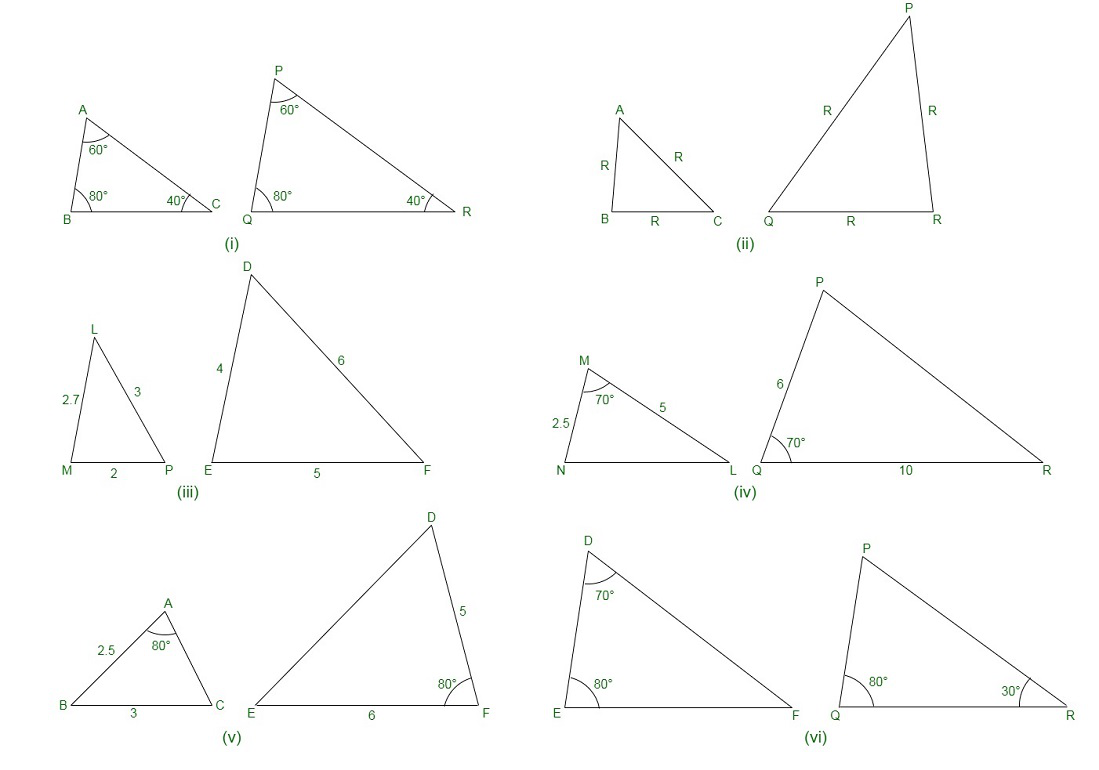
Solution:
(i) We have, in ΔABC and ΔPQR,
∠A = ∠P = 60°
∠B = ∠Q = 80°
∠C = ∠R = 40°
By AAA similarity criterion, we have
∴ ΔABC ~ ΔPQR
(ii) We have, in ΔABC and ΔPQR,
Computing the ratios of corresponding sides,
AB/QR = 2.5/5 = 1/2
BC/RP = 2/4 = 1/2
CA/PQ = 3/6 = 1/2
AB/QR = BC/RP = CA/PQ
Now,
By SSS similarity criterion, we have
ΔABC ~ ΔQRP
(iii) We have, in ΔLMP and ΔDEF,
Now,
LM = 2.7, MP = 2, LP = 3, EF = 5, DE = 4, DF = 6
Computing the ratios of the corresponding sides,
MP/DE = 2/4 = 1/2
PL/DF = 3/6 = 1/2
LM/EF = 2.7/5 = 27/50
Since, MP/DE = PL/DF ≠ LM/EF
Therefore, ΔLMP and ΔDEF are not similar.
(iv) In ΔMNL and ΔQPR, it is given,
Computing the ratios of the corresponding sides,
MN/QP = ML/QR = 1/2
And,
∠M = ∠Q = 70°
By SAS similarity criterion
ΔMNL ~ ΔQPR
(v) In ΔABC and ΔDEF, we have,
AB = 2.5, BC = 3, ∠A = 80°, EF = 6, DF = 5, ∠F = 80°
Computing the ratios of the corresponding sides,
AB/DF = 2.5/5 = 1/2
And, BC/EF = 3/6 = 1/2
⇒ ∠B ≠ ∠F
Therefore, ΔABC and ΔDEF are not similar.
(vi) In ΔDEF,
By angle sum property of a triangle,
∠D + ∠E + ∠F = 180°
⇒ 70° + 80° + ∠F = 180°
⇒ ∠F = 180° – 70° – 80°
⇒ ∠F = 30°
Similarly, In ΔPQR,
By angle sum property of a triangle,
∠P + ∠Q + ∠R = 180
⇒ ∠P + 80° + 30° = 180°
⇒ ∠P = 180° – 80° -30°
⇒ ∠P = 70°
Now, in ΔDEF and ΔPQR, we have
∠D = ∠P = 70° [equal corresponding angles]
∠F = ∠Q = 80°
∠F = ∠R = 30°
Therefore,
By AAA similarity criterion,
ΔDEF ~ ΔPQR
Question 2. In the figure, ΔODC ∝ ¼ ΔOBA, ∠ BOC = 125° and ∠ CDO = 70°. Find ∠ DOC, ∠ DCO, and ∠ OAB.
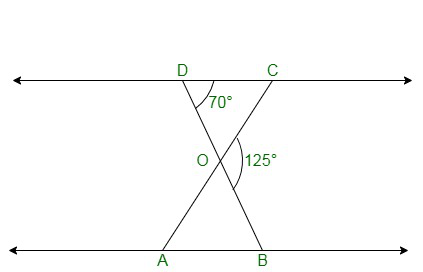
Solution:
We know, DOB is a straight line, as given.
Therefore, ∠DOC + ∠COB = 180°
Also,
∠BOC = 125°
⇒ ∠DOC = 180° – 125°
= 55°
In ΔDOC
By angle sum property of a triangle,
∠DCO + ∠CDO + ∠DOC = 180°
∠CDO = 70°
⇒ ∠DCO + 70º + 55º = 180°
⇒ ∠DCO = 55°
Also, given,
ΔODC ∝ ¼ ΔOBA,
Therefore, ΔODC ~ ΔOBA.
Since, we know that the corresponding angles are equal in similar triangles,
Therefore, ∠OAB = ∠OCD
⇒ ∠ OAB = 55°
∠OAB = ∠OCD
∠OAB = 55°
Question 3. Diagonals AC and BD of a trapezium ABCD with AB || DC intersect each other at the point O. Using a similarity criterion for two triangles, show that AO/OC = OB/OD
Solution:
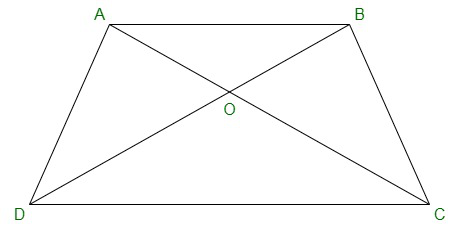
In ΔDOC and ΔBOA,
Since, AB || CD, therefore the alternate interior angles are equal,
That is, ∠CDO = ∠ABO ….(i)
And,
∠DCO = ∠BAO …(ii)
Also, vertically opposite angles are equal;
That is,∠DOC = ∠BOA…(iii)
Hence, by AAA similarity criterion,
ΔDOC ~ ΔBOA [From eq(i) , (ii) and (iii)]
Since the triangles are similar, therefore the corresponding sides are proportional.
DO/BO = OC/OA
⇒OA/OC = OB/OD
Hence, proved.
Question 4. In the fig., QR/QS = QT/PR and ∠1 = ∠2. Show that ΔPQS ~ ΔTQR.

Solution:
We have,
In ΔPQR,
∠PQR = ∠PRQ
That is, PQ = PR .…(i)
Given,
QR/QS = QT/PR
By using eq(i), we obtain,
QR/QS = QT/QP …….(ii)
In ΔPQS and ΔTQR,
QR/QS = QT/QP [By using eq(ii)]
∠Q = ∠Q
By SAS similarity criterion, therefore,
ΔPQS ~ ΔTQR
Question 5. S and T are point on sides PR and QR of ΔPQR such that ∠P = ∠RTS. Show that ΔRPQ ~ ΔRTS.
Solution:
We know,
S and T are the points on sides PR and QR of ΔPQR.
And, ∠P = ∠RTS.

In ΔRPQ and ΔRTS,
Given,
∠RTS = ∠QPS
∠R = ∠R (Common angle)
By AAA similarity criterion,
∴ ΔRPQ ~ ΔRTS
Question 6. In the figure, if ΔABE ≅ ΔACD, show that ΔADE ~ ΔABC.
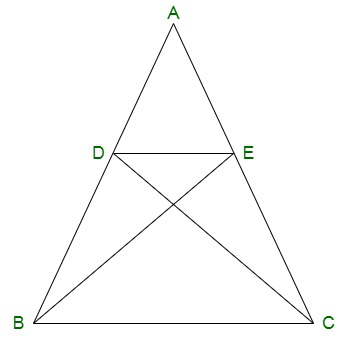
Solution:
Given, ΔABE ≅ ΔACD.
By CPCT, we have
∴ AB = AC ……….(i)
And, AD = AE …………(ii)
In ΔADE and ΔABC,
On dividing the eq.(ii) by eq(i), we obtain,
AD/AB = AE/AC
Also, by common angle,
∠A = ∠A
By SAS similarity criterion, we have,
∴ ΔADE ~ ΔABC
Question 7. In the figure, altitudes AD and CE of ΔABC intersect each other at the point, P. Show, that:
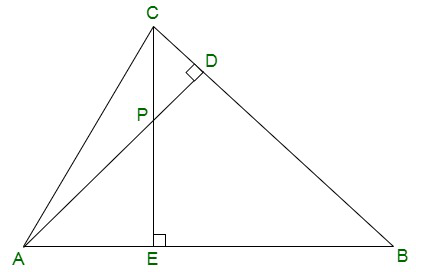
(i) ΔAEP ~ ΔCDP
(ii) ΔABD ~ ΔCBE
(iii) ΔAEP ~ ΔADB
(iv) ΔPDC ~ ΔBEC
Solution:
Given, altitudes AD and CE of ΔABC intersect each other at the point P.
(i) In ΔAEP and ΔCDP,
Since, both of the angles are 90° each.
∠AEP = ∠CDP
Since,
∠APE = ∠CPD (Vertically opposite angles)
By AA similarity criterion, we have,
ΔAEP ~ ΔCDP
(ii) In ΔABD and ΔCBE,
Since, both of the angles are 90° each.
∠ADB = ∠CEB
∠ABD = ∠CBE (Common Angles)
By AA similarity criterion, we have,
ΔABD ~ ΔCBE
(iii) In ΔAEP and ΔADB,
Since, both of the angles are 90° each.
∠AEP = ∠ADB
∠PAE = ∠DAB (Common angles)
By AA similarity criterion, we have,
ΔAEP ~ ΔADB
(iv) In ΔPDC and ΔBEC,
Since, both of the angles are 90° each.
∠PDC = ∠BEC
∠PCD = ∠BCE (Common angles)
By AA similarity criterion, we have,
ΔPDC ~ ΔBEC
Question 8. E is a point on the side AD produced of a parallelogram ABCD and BE intersects CD at F. Show that ΔABE ~ ΔCFB.
Solution:
Given,
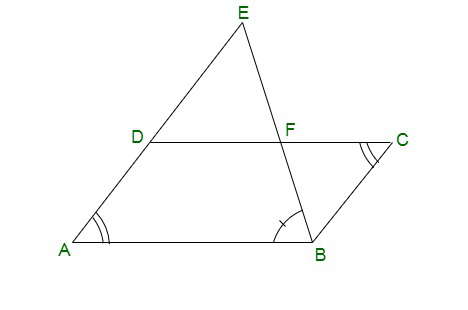
E is a point on the side AD produced of a parallelogram ABCD and BE intersects CD at F.
Now,
In ΔABE and ΔCFB,
Since, the opposite angles of a parallelogram are equal, we have,
∠A = ∠C
Also, since AE || BC
∠AEB = ∠CBF (Alternate interior angles)
By AA similarity criterion,
∴ ΔABE ~ ΔCFB
Question 9. In the figure, ABC and AMP are two right triangles, right-angled at B and M respectively, prove that:
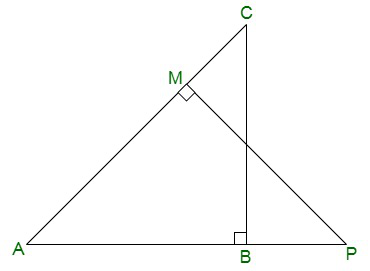
(i) ΔABC ~ ΔAMP
(ii) CA/PA = BC/MP
Solution:
Given,
ABC and AMP are two right triangles, right-angled at B and M respectively.
(i) In ΔABC and ΔAMP, we have,
∠CAB = ∠MAP (common angles)
Since, both of the angles are equivalent to 90°
∠ABC = ∠AMP
By AA similarity criterion, we have,
∴ ΔABC ~ ΔAMP
(ii) As, ΔABC ~ ΔAMP (AA similarity criterion) [proved in part (i)]
Therefore, we know,
If two triangles are similar then the corresponding sides are always equal,
Hence, CA/PA = BC/MP
Question 10. CD and GH are respectively the bisectors of ∠ACB and ∠EGF such that D and H lie on sides AB and FE of ΔABC and ΔEFG respectively. If ΔABC ~ ΔFEG, Show that:
(i) CD/GH = AC/FG
(ii) ΔDCB ~ ΔHGE
(iii) ΔDCA ~ ΔHGF
Solution:
Given,
CD and GH are respectively the bisectors of ∠ACB and ∠EGF such that D and H lie on sides AB and FE of ΔABC and ΔEFG respectively.
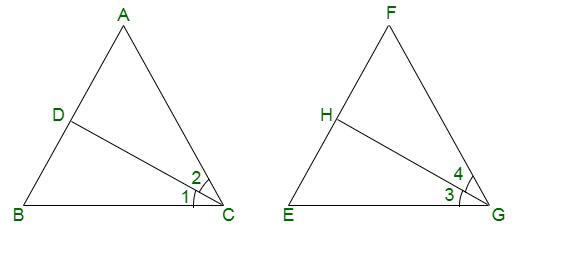
(i) We have,
ΔABC ~ ΔFEG.
Therefore,
∠A = ∠F, ∠B = ∠E, and ∠ACB = ∠FGE
Now, since,
∠ACB = ∠FGE
∴ ∠ACD = ∠FGH (Angle bisector)
And, ∠DCB = ∠HGE
In ΔACD and ΔFGH,
∠A = ∠F
∠ACD = ∠FGH
By AA similarity criterion, we have,
∴ ΔACD ~ ΔFGH
⇒CD/GH = AC/FG
(ii) In ΔDCB and ΔHGE,
Proved in part (i)
∠DCB = ∠HGE
∠B = ∠E
By AA similarity criterion,
∴ ΔDCB ~ ΔHGE
(iii) In ΔDCA and ΔHGF,
Since, we have already proved,
∠ACD = ∠FGH
∠A = ∠F
By AA similarity criterion,
∴ ΔDCA ~ ΔHGF
Question 11. In the following figure, E is a point on side CB produced of an isosceles triangle ABC with AB = AC. If AD ⊥ BC and EF ⊥ AC, prove that ΔABD ~ ΔECF.
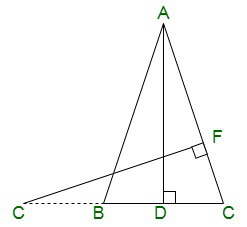
Solution:
Given, ABC is an isosceles triangle.
Since, the sides of an isosceles triangle are equal, we have,
∴ AB = AC
⇒ ∠ABD = ∠ECF
In ΔABD and ΔECF,
Since, each of the following angles are 90°.
∠ADB = ∠EFC
Since, we have already proved,
∠BAD = ∠CEF
By AA similarity criterion, we have,
∴ ΔABD ~ ΔECF
Question 12. Sides AB and BC and median AD of a triangle ABC are respectively proportional to sides PQ and QR and median PM of ΔPQR (see Fig 6.41). Show that ΔABC ~ ΔPQR.
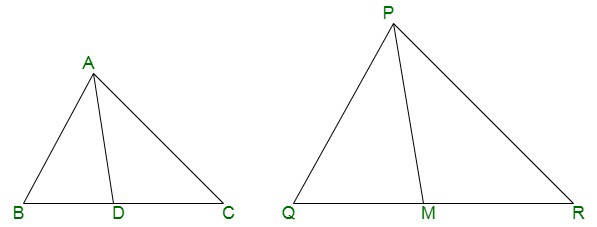
Solution:
Given that in ΔABC and ΔPQR,
AB is proportional to PQ
BC is proportional to QR
AD is proportional to PM
That is, AB/PQ = BC/QR = AD/PM
We know,
AB/PQ = BC/QR = AD/PM
Since, D is the midpoint of BC and M is the midpoint of QR
⇒AB/PQ = BC/QR = AD/PM
By SSS similarity criterion, we have,
⇒ ΔABD ~ ΔPQM
Now, since the corresponding angles of two similar triangles are equal, we obtain,
∴ ∠ABD = ∠PQM
⇒ ∠ABC = ∠PQR
Now,
In ΔABC and ΔPQR
AB/PQ = BC/QR ………….(i)
∠ABC = ∠PQR ……………(ii)
From equation (i) and (ii), we get,
By SAS similarity criterion, we have,
ΔABC ~ ΔPQR
Question 13. D is a point on the side BC of a triangle ABC such that ∠ADC = ∠BAC. Show that CA2 = CB.CD
Solution:
Given, D is a point on the side BC of a triangle ABC such that ∠ADC = ∠BAC.

In ΔADC and ΔBAC,
∠ADC = ∠BAC
∠ACD = ∠BCA (Common angles)
By AA similarity criterion, we have,
∴ ΔADC ~ ΔBAC
Since, the corresponding sides of similar triangles are in proportion, we obtain,
∴ CA/CB = CD/CA
That is, CA2 = CB.CD.
Hence, proved.
Question 14. Sides AB and AC and median AD of a triangle ABC are respectively proportional to sides PQ and PR and median PM of another triangle PQR. Show that ΔABC ~ ΔPQR.
Solution:
Given, Two triangles ΔABC and ΔPQR in which AD and PM are medians such that;
Now,
AB/PQ = AC/PR = AD/PM
Construction,
Produce AD further to E so that AD = DE. Now, join CE.
Similarly, produce PM further until N such that PM = MN. Join RN.
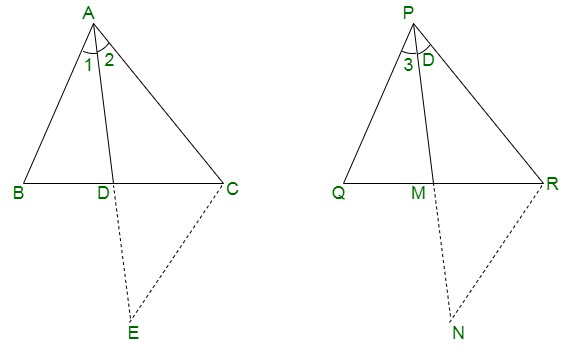
In ΔABD and ΔCDE, we have
From the construction done,
AD = DE
Now, since AP is the median,
BD = DC
and, ∠ADB = ∠CDE [Vertically opposite angles are equal]
By SAS criterion,
∴ ΔABD ≅ ΔCDE
By CPCT, we have,
⇒ AB = CE……………..(i)
In ΔPQM and ΔMNR,
From the construction done,
PM = MN
Now, since PM is the median,
QM = MR
and, ∠PMQ = ∠NMR [Vertically opposite angles are equal]
By SAS criterion,
∴ ΔPQM = ΔMNR
By CPCT,
⇒ PQ = RN …………………(ii)
Now, AB/PQ = AC/PR = AD/PM
From equation (i) and (ii), we conclude,
⇒CE/RN = AC/PR = AD/PM
⇒ CE/RN = AC/PR = 2AD/2PM
We know,
2AD = AE and 2PM = PN.
⇒ CE/RN = AC/PR = AE/PN
By SSS similarity criterion,
∴ ΔACE ~ ΔPRN
Thus,
∠2 = ∠4
And, ∠1 = ∠3
∴ ∠1 + ∠2 = ∠3 + ∠4
⇒ ∠A = ∠P ………………….(iii)
Now, in ΔABC and ΔPQR, we have
AB/PQ = AC/PR [Given]
From equation (iii), we have,
∠A = ∠P
By SAS similarity criterion,
∴ ΔABC ~ ΔPQR
Question 15. A vertical pole of a length 6 m casts a shadow 4m long on the ground and at the same time a tower casts a shadow 28 m long. Find the height of the tower.
Solution:
Given, Length of the vertical pole = 6m
Length of shadow of the tower = 28 m
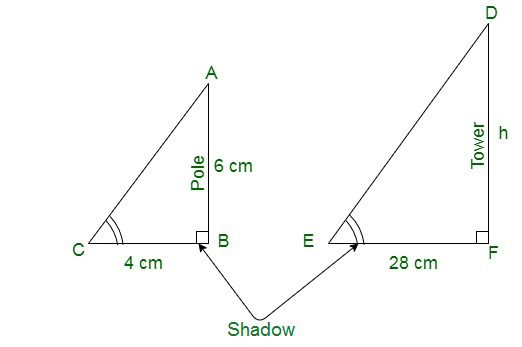
Shadow of the pole = 4 m
Let us assume the height of tower to be h m.
In ΔABC and ΔDEF,
∠C = ∠E (By angular elevation of sum)
Since, the following angles are equivalent to 90°
∠B = ∠F
By AA similarity criterion, we have,
∴ ΔABC ~ ΔDEF
Since, if two triangles are similar corresponding sides are proportional
∴ AB/DF = BC/EF
Substituting values,
∴ 6/h = 4/28
⇒h = (6×28)/4
⇒ h = 6 × 7
⇒ h = 42 m
Hence, the height of the tower specified is 42 m.
Question 16. If AD and PM are medians of triangles ABC and PQR, respectively where ΔABC ~ ΔPQR prove that AB/PQ = AD/PM.
Solution:
Given, ΔABC ~ ΔPQR
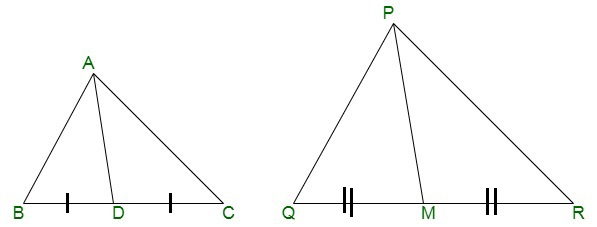
Since, the corresponding sides of similar triangles are in proportion.
∴ AB/PQ = AC/PR = BC/QR……………(i)
And, ∠A = ∠P, ∠B = ∠Q, ∠C = ∠R ………….…..(ii)
Since, AD and PM are the medians, they will divide their opposite sides correspondingly.
∴ BD = BC/2 and QM = QR/2 ………….(iii)
From equations (i) and (iii), we obtain,
AB/PQ = BD/QM …………….(iv)
In ΔABD and ΔPQM,
From equation (ii), we have
∠B = ∠Q
From equation (iv), we have,
AB/PQ = BD/QM
By SAS similarity criterion, we have,
∴ ΔABD ~ ΔPQM
That is, AB/PQ = BD/QM = AD/PM
NCERT Solutions for Class 10 Maths Chapter 6 Triangles: Exercise 6.4
Question 1. Let ∆ ABC ~ ∆ DEF and their areas be, respectively, 64 cm2 and 121 cm2. If EF = 15.4 cm, find BC.
Solution:

According to the theorem 1, we get





BC =  × 15.4
× 15.4
BC = 11.2 cm
Question 2. Diagonals of a trapezium ABCD with AB || DC intersect each other at the point O. If AB = 2 CD, find the ratio of the areas of triangles AOB and COD.
Solution:
Given, ABCD is a trapezium with AB || DC. Diagonals AC and BD intersect each other at point O.

In △AOB and △COD,
∠ AOB = ∠ COD (Opposite angles)
∠ 1 = ∠ 2 (Alternate angles of parallel lines)
△AOB ~ △COD by AA property.
According to the theorem 1, we get

As, AB = 2CD
= 
= 
= 
ar(AOB) : ar(COD) = 4 : 1
Question 3. In Figure, ABC and DBC are two triangles on the same base BC. If AD intersects BC at O, show that  .
.

Solution:
Let’s draw two perpendiculars AP and DM on line BC.
Area of triangle = ½ × Base × Height

 ……………………………(1)
……………………………(1)
In ΔAPO and ΔDMO,
∠APO = ∠DMO (Each 90°)
∠AOP = ∠DOM (Vertically opposite angles)
ΔAPO ~ ΔDMO by AA similarity
 ……………………………(2)
……………………………(2)
From (1) and (2), we can conclude that

Question 4. If the areas of two similar triangles are equal, prove that they are congruent.
Solution:

As it is given, ΔABC ~ ΔDEF
According to the theorem 1, we have

 =1 [Since, Area(ΔABC) = Area(ΔDEF)
=1 [Since, Area(ΔABC) = Area(ΔDEF)
BC2 = EF2
BC = EF
Similarly, we can prove that
AB = DE and AC = DF
Thus, ΔABC ≅ ΔPQR [SSS criterion of congruence]
Question 5. D, E and F are respectively the mid-points of sides AB, BC, and CA of ∆ ABC. Find the ratio of the areas of ∆ DEF and ∆ ABC.
Solution:

As, it is given here
DF = ½ BC
DE = ½ AC
EF = ½ AB
So, 
Hence, ΔABC ~ ΔDEF
According to theorem 1,


ar(ΔDEF) : ar(ΔABC) = 1 : 4
Question 6. Prove that the ratio of the areas of two similar triangles is equal to the square of the ratio of their corresponding medians.
Solution:

Given: AM and DN are the medians of triangles ABC and DEF respectively.
ΔABC ~ ΔDEF
According to theorem 1,

So, 
 ……………………….(1)
……………………….(1)
∠B = ∠E (because ΔABC ~ ΔDEF)
Hence, ΔABP ~ ΔDEQ [SAS similarity criterion]
 ……………………….(2)
……………………….(2)
From (1) and (2), we conclude that

Hence, proved!
Question 7. Prove that the area of an equilateral triangle described on one side of a square is equal to half the area of the equilateral triangle described on one of its diagonals.
Solution:

Let’s take side of square = a
Diagonal of square AC = a√2
As, ΔBCF and ΔACE are equilateral, so they are similar
ΔBCF ~ ΔACE
According to theorem 1,

=
 = 2
= 2
Hence, Area of (ΔBCF) = ½ Area of (ΔACE)
Tick the correct answer and justify:
Question 8. ABC and BDE are two equilateral triangles such that D is the mid-point of BC. Ratio of the areas of triangles ABC and BDE is
(A) 2 : 1 (B) 1 : 2 (C) 4 : 1 (D) 1 : 4
Solution:
Here,
AB = BC = AC = a
and, BE = BD = ED = ½a

ΔABC ~ ΔEBD (Equilateral triangle)
According to theorem 1,


Area of (ΔABC) : Area of (ΔEBD) = 4 : 1
Hence, OPTION (C) is correct.
Question 9. Sides of two similar triangles are in the ratio 4 : 9. Areas of these triangles are in the ratio
(A) 2 : 3 (B) 4 : 9 (C) 81 : 16 (D) 16 : 81
Solution:

ΔABC ~ ΔDEF

According to theorem 1,


Area of (ΔABC) : Area of (ΔDEF) = 16 : 81
Hence, OPTION (D) is correct.
NCERT Solutions for Class 10 Maths Chapter 6 Triangles: Exercise 6.5
Question 1. Sides of triangles are given below. Determine which of them are right triangles? In the case of a right triangle, write the length of its hypotenuse.
(i) 7 cm, 24 cm, 25 cm
(ii) 3 cm, 8 cm, 6 cm
(iii) 50 cm, 80 cm, 100 cm
(iv) 13 cm, 12 cm, 5 cm
Solution:
(i) Given: 7cm, 24cm, 25cm
(25)2= 25 * 25 = 625
∴They are sides of a right ∆ and hypotenuse = 625
(ii) Given: 3cm, 8cm, 6cm
(8)2 = 8 * 8 = 64
They are not side of right triangle.
(iii) Given: 50cm, 80cm, 100cm
(100)2 = 100 * 100 = 10000
(50)2 + (80)2 = 2500 + 6400
Therefore, this is not right triangle.
(iv) Given: 13cm, 12cm, 5cm
(13)2 = 13 * 13 = 169
(12)2 + (5)2 = 169
Therefore, this is the sides of right triangle and hypotenuse = 169
Question 2. PQR is a triangle right-angled at P and M is a point on QR such that PM ⊥ QR. Show that PM2 = QM × MR.
Solution:
Given: A right ∆PQR right-angled at P and PM⊥QR
To show: PM2 = QM * MR
PM * PM = QM * MR
In ∆PMQ and ∆PMR
∠1 =∠2 -(each 90°)
∠1 +∠2 +∠3 = 180°
90° + ∠4 + ∠5 = 180°
∠4 +∠5 = 180° – 90°
∠3 + ∠4 = 180° – 90°
∠4 +∠5 = ∠3 +∠4
∴∠5 =∠3
∴∆PMQ ~ ∆RMP


MP2 = MQ.PM
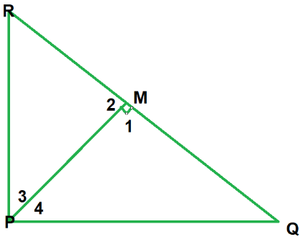
Question 3. In Fig., ABD is a triangle right angled at A and AC ⊥ BD. Show that
(i) AB2 = BC × BD
(ii) AC2 = BC × DC
(iii) AD2 = BD × CD
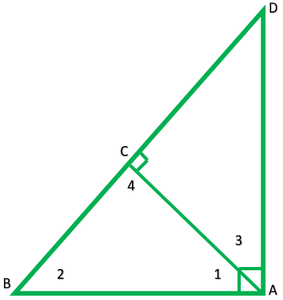
Solution:
Given: A right ∆ABD, right angled at A and AC⊥ BD
To show:
(i)AB2 = BC × BD
(ii) AC2 = BC × DC
(iii) AD2 = BD × CD
(i) AB2 = BC × BD
AB * AB = BC.BD
In ∆ ABC and ∆ABD
∠B =∠B -(common)
∠BCA = ∠A -(each 90°)
∴ ∆ABC~∆DBA

AB2 = BC * DC
(ii) AC2 = BC * DC
AC * AC = BC * DC
In ∆ABC and ∆ACD
∠ACB = ∠ACD -(each 90°)
In ∆ ACB
∠1 + ∠2 + ∠3 = 180°
∠1 + ∠2 + 90° = 180°
∠1 + ∠2 = 90° -(1)
∠1 + ∠3 = 90° -(2)
∠1 + ∠2 =∠1 + ∠3
∴ ∠2 = ∠3
∴ ∆ABC~∆DAC

AC2 = BC * CD
(iii) AD2 = BD × CD
In ∆ABD and ∆ACD
∠A =∠ACD -(each 90)
∠D =∠D -(common)
∴ ∆ABD~∆CAD -(AA similarity)

AD2 = BD * CD
Question 4. ABC is an isosceles triangle right angled at C. Prove that AB2 = 2AC2.
Solution:
Given: ∆ABC right angled at B
To prove: AB2 = 2AC2
According to Pythagoras theorem,
(AB)2 = (AC)2 + (BC)2
(AB)2 = (AC)2 + (AC)2 -(BC = AC)
AB2 = 2AC2
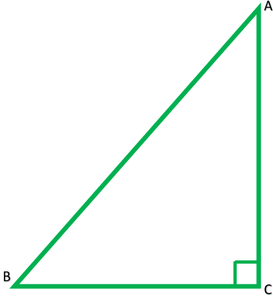
Question 5. ABC is an isosceles triangle with AC = BC. If AB2 = 2AC2, prove that ABC is a right triangle.
Solution:
Given: ∆ABC is an isosceles triangle in which
AC = BC
AB2 = 2AC2
To prove: ABCD is right ∆
AB2 = 2AC2
AB2 = AC2 + AC2
∴ By the, converse of Pythagoras theorem ∆ACB is a right ∆ at C.
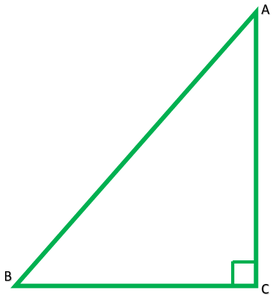
Question 6. ABC is an equilateral triangle of side 2a. Find each of its altitudes.
Solution:
Let ABC is an equilateral triangle of each 2a units
Construction: Draw AD ⊥ BC
In right ∆ ADB
(AB)2 = (AD)2 + (BD)2
(2a)2 = (AD)2 + (a)2
(4a)2 = (AD)2 + a2
4a2 – a2 = (AD)2
3a2 = (AB)2
√3 a2 = AD ∴ Each of its altitude= √3 a unit
√3 a = AD

Question 7. Prove that the sum of the squares of the sides of the rhombus is equal to the sum of the squares of its diagonals.
Solution:
Given: ABCD is a rhombus
To prove: AB2 + BC2 + CD2 + DA2
Proof: ABCD is rhombus and let diagonals AC and BD bisect each other at O.
∴ ∠AOB =∠BOC =∠COD =∠DOA = 90°
In ∆AOB
AB2 = AC2 + BO2
AB2 = (1/2AC2) + (1/2BD2)
AB2 = 1/4(AC2 + BD2)
4AB2 = AC2 + BD2 -(1)
Similarly, in ∆BOC
4BC2 = AC2 + BD2 -(2)
4CD2 = AC2 + BD2 -(3)
4AD2 = AC2 + BD2 -(4)
Adding 1, 2, 3, and 4
4AB2 + 4BC2 + 4CD2 + 4DA2 = 4(AC2 + BD2)
4(AB2 + BC2 + CD2 + DA2) = 4(AC2 + BD2)
∴ AB2 + BC2 + CD2 + DA2 = AC2 + BD2
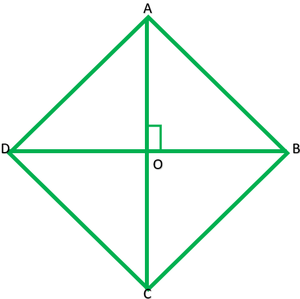
Question 8. In Fig. 6.54, O is a point in the interior of a triangle diagonals.
(i) OA2 + OB2 + OC2 – OD2 – OE2 – OF2 = AF2 + BD2 + CE2
(ii) AF2 + BD2 + CE2 = AE2 + CD2 + BF2
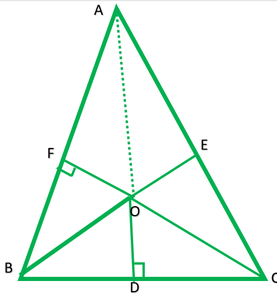
Solution:
(i) In right ∆AFO, by Pythagoras theorem
OA2 = AP2 + OF2 -(1)
In right ∆ODB, by Pythagoras theorem
OB2 = BD2 + OD2 -(2)
In right ∆OEC, by Pythagoras theorem
OC2 = CE2 + OE2 -(3)
Adding 1, 2, and 3
OA2 + OB2 + OC2 = AF2 + BD2 + CF2 + OD2 + OE2
OA2 + OB2 + OC2 – OE2 – OD2 – OE2 = AF2 + BD2 + CE2
(ii) AF2 + BD2 + CE2 = AE2 + CD2 + BF2
OB2 = BD2 + OD2 -(1)
OC2 = DC2 + OD2 -(2)
Subtracting (1) from (2) we get,
OB2 – OC2 = BD2 + OD2 – (DC2 + OD2)
= BD2 + OD2 – DC2 – OD2
= BD2 – DC2 -(3)
Similarly,
OC2 – AD2 = CE2 – EA2 -(4)
AO2 = BO2 = AF2 – FB2 -(5)
Adding 3, 4, and 5, we get,
OB2 – OC2 + OC2 – AO2 + AO2 – BO2 = BD2 – DC2 + CE2 – EA2 + AF2 – FB2
0 + DC2 + EA2 + FB2 = BD2 + CD2 + AF2
Question 9. A ladder 10 m long reaches a window 8 m above the ground. Find the distance of the foot of the ladder from base of the wall.
Solution:
AB is wall = 8m
AC is ladder = 10m
BC = ?
In right ∆ABC, by Pythagoras theorem
(AC)2 = (AB)2 + (BC)2
(10)2 = (8)2 + (BC)2
100 = 64 + (BC)2
100 – 64 = (BC)2
36 = (BC)2
√36 = BC
√(6 * 6) = BC
6 = BC
Hence, the foot of the ladder is at a distance of 6 m from the base of the wall.
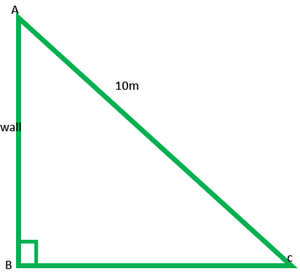
Question 10. A guy wire attached to a vertical pole of height 18 m is 24 m long and has a stake attached to the other end. How far from the base of the pole should the stake be driven so that the wire will be taut?
Solution:
In fig.
AB is pole = 18m
AC is wire = 24m
BC = ?
In right ∆ABC, by Pythagoras theorem
(AC)2 = (AB)2 + (BC)2
(24)2 = (18)2 + (BC)2
576 = 324 + (BC)2
576 – 324 = (BC)2
252 = (BC)2
√252 = BC
√(2 * 2 * 3 * 3 * 7) = BC
2 * 3√7 = BC
6√7 = BC
∴ Hence, the stake may be placed at distance of 6√7 from the base of the pole.
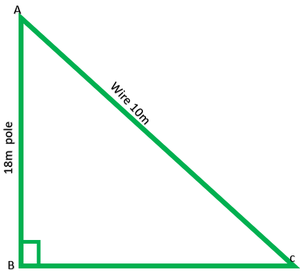
Question 11. An aeroplane leaves an airport and flies due north at a speed of 1,000 km per hour. At the same time, another aeroplane leaves the same airport and flies due west at a speed of 1,200 km per hour. How far apart will be the two planes after  hours?
hours?
Solution:
Distance covered by place left towards north = 1000 * 1.5
Distance covered by place left towards west = 1200 * 1.5 = 1800km
In right ∆ABC by Pythagoras theorem
(AC)2 = (AB)2 + (BC)2
(AC)2 = (1500)2 + (1800)2
= 250000 + 3240000
= 5490000
= √(3 * 3 * 61 * 10 * 10 * 10 * 10)
= 3 * 10 * 10√61
AC = 300√61
Distance between the two poles 300√61km

Question 12. Two poles of heights 6 m and 11 m stand on a plane ground. If the distance between the feet of the poles is 12 m, find the distance between their tops.
Solution:
AB is pole of height = 11m
DC is another pole of height = 6m
BC = 12m
In fig. DE = BC = 12m
AE = AB – EB
= 11 – 6
= 5m
In right ∆AED, by Pythagoras theorem
(AD)2 = (AC)2 + (DE)2
(AD)2 = (5)2 + (12)2
(AD)2 = 25 + 144
AD = √169
AD = √(13 * 13)
AD = 13
Hence, the distance between the tops of the two poles is 13m.

Question 13. D and E are points on the sides CA and CB respectively of a triangle ABC right angled at C. Prove that AE2 + BD2 = AB2 + DE2.
Solution:
To prove: (AE)2 + (BD)2 = (AB)2 + (DE)2
Construction: Join AE, BD and DE
Proof:
In ∆ACE, by Pythagoras theorem
(AE)2 = (AC)2 + (EC)2 -(1)
In ∆DCB, by Pythagoras theorem
(BD)2 = (DC)2 + (BC)2 -(2)
In ∆ACB, by Pythagoras theorem
(AB)2 = (AC)2 + (CB)2 -(3)
In ∆DCE, by Pythagoras theorem
(ED)2 = (DC)2 + (CE)2
Adding eq (1) and (2)
(AE)2 + (BD)2 = (AC)2 + (EC)2 + (DC)2 + (DC)2
= (AC2 + BC2) + (EC2 + DC2)
= AB2 + DE2 -(from 3 and 4)

Question 14. The perpendicular from A on side BC of a Δ ABC intersects BC at D such that DB = 3CD (see Fig.). Prove that 2AB2 = 2AC2 + BC2.

Solution:
Given: DB = 3CD
To prove: 2AB2 = 2AC2 + BC2
Proof: DB = 3CD
BC = CD + DB
BC = CD + 3CD
BC = 4CD
BC/4 = CD -(1)
DB = 3(BC/4) -(2)
In right ∆ADB, by Pythagoras theorem
AB2 = AD2 + DB2 -(3)
In right ∆ADC, by Pythagoras theorem
AC2 = AD2 + CD2 -(4)
Subtract eq(3) from (4)
AB2 – AC2 = AD2 + DB2 – (AD2 + CD2)
= AD2 + DB2 + AD2 – CD2
= DB2 – CD2
= (3/4BC)2 – (BC/4)2
= 9/6BC2 – BC/16
= 8BC2/16
= AB2 – AC2 = BC2/2
2AB2 – 2AC2 = BC2
2AB2 = 2AC2 + BC2
Question 15. In an equilateral triangle ABC, D is a point on side BC such that BD = 1/3BC. Prove that 9AD2 = 7AB2.
Solution:
Prove that 9AD2 = 7AB2
Construction: Join AD and draw AE perpendicular BC
Let each side, AB = AC = BC = a
BD = 1/3BC = 1/3a
BC = 1/2BC = 1/2a
DE = BE – BD
= 1/2a – 1/3a
= 3a – 2a/6
= DE = a/6
In right ∆AED, by Pythagoras theorem
AD2 = AE2 + DE2
AD2 = (√3a/2)2 + (a/6)2
= 3a2/4+ a2/36
= 27a2/36 + a2/36
AD2 = 28a2/36
AD2 = 7a2/9
9AD2 = 7a2
9AD2 = 7AB2

Question 16. In an equilateral triangle, prove that three times the square of one side is equal to four times the square of one of its altitudes.
Solution:
To prove: 3AB2 = 4AD2
Proof: Let each side of one equilateral ∆ = a
BD = 1/2a -[perpendicular bisects the side in on an equilateral ∆]
In right ∆ADB, by Pythagoras theorem
(AB)2=(AD)2 + (BD)2
(a)2 = (AD)2 + (1/2a)2
a2 = AD2 + (a/2)2
a2 – a2/4 = AD2
3a2/4 = AD2
3a2 = 4AD2
3AB2 = 4AD2

Question 17. Tick the correct answer and justify: In ΔABC, AB = 6√3 cm, AC = 12 cm and BC = 6 cm. The angle B is:
(A) 120° (B) 60°
(C) 90° (D) 45°
Solution:
(AC)2 = (12)2 = 144
(AB)2 = (6√3)2 = 6 * 6√3 = 36 * 3 = 108
(BC)2 = (6)2 = 36
(AB)2 + (BC)2 = 108 + 36 = 144
∴ It is right ∆ thus ∠B = 90°

NCERT Solutions for Class 10 Maths Chapter 6 Triangles: Exercise 6.6
Question 1. In Fig., PS is the bisector of ∠QPR of ΔPQR. Prove that

Solution:
Given: PS is angle bisector of ∠QPR.
To prove: 
Construction: Draw RT∥ST to cut OP provided at T.
Proof: since PS∥TR and PR cuts them, hence we have,
∠1 = ∠3 ——[alternate interior angle] 1
∠1 = ∠4 ——[corresponding angle] 2
But ∠1 = ∠2 [given]
From 1 and 2
∴∠3=∠4
In ∆PTR,
PT = PR [sides opposite to equal angle are equal] 3
Now In ∆QRT, we have
 ———-[by B.P.T]
———-[by B.P.T]
 ———[from 3]
———[from 3]
Question 2. In Fig., D is a point on hypotenuse AC of ΔABC, such that BD ⊥ AC, DM ⊥ BC and
DN ⊥ AB. Prove that:
(i) DM2 = DN.MC
(ii) DN2 = DM.AN

Solution:
Given: BD ⊥ AC, DM ⊥ BC and DN ⊥ AB
To prove:
(i) DM2 = DN.MC
(ii) DN2 = DM.AN
Proof: we have AB⊥BC and DM⊥BC
So, AB || DM
Similarly, we have CB⊥AB and DN ⊥ AB
Therefore, CB || DN
Hence, BMD DN is a triangle
∴BM=DN or DM=ND
In ∆BMD,
∠1+ ∠2+ ∠DMB=180 ———–[angle sum property of triangle]
∠1+ ∠2+90=180
∠1+ ∠2=180-90
∠1+ ∠2=90 ——————-1
Similarly, in ∆DMC,
∠3+ ∠4=90° _______2
∴ from 1 and 2
∠1+ ∠2=∠2+ ∠3
∠1=∠3
From 2 and 3
∠3+ ∠4=∠2+ ∠3
∠4=∠2
Now in ∆BMD and ∆DMC,
∠1=∠3
∠2=∠4
∴∆BMD~∆DMC ——-(AA similarity criteria)


DM2=DN*MC
II) proceeding as in (i), we can prove that ∆BND~∆DNA

 [BN=NA]
[BN=NA]
DN2 = MN*MC
Question 3. In Fig., ABC is a triangle in which ∠ABC > 90° and AD ⊥ CB produced. Prove that AC2 = AB2 + BC2 + 2 BC.BD.

Given: In ∆ABC, ∠ABC > 90° and AD⊥CB provided.
To prove: (AC)2= AB2+BC2+ 2 BC.BD
Proof: In ∆ADB by Pythagoras theorem,
AC2=AD2+AB2
(AC)2= (AD)2+(DB)2 ———1
In ∆ADC by Pythagoras theorem,
(AC)2= (AD)2+(DC)2 ———2
AC2= AD2+DB2 ———1
AC2= AD2+(DB)2+2*DB*BC
AC2= AD2+(DB)2+BC2+2*DB*BC
Question 4. In Figure, ABC is a triangle in which ∠ABC < 90° and AD ⊥ BC. Prove that AC2 = AB2 + BC2 – 2BC.BD.

Solution:
Given: In ∆ABC, ∠ABC < 90° and AD ⊥ BC.
To prove: AC2 = AB2 + BC2 – 2*BC.BD
Proof: In triangle ADB, by Pythagoras theorem
AB2=AD2 +BD2 ———1
In triangle ADC, by Pythagoras theorem
AC2=AD2+DC2 ———2
AC2=AD2+ BC2 +BD2
AC2=AD2+ BC2 +BD2 – 2*BC*BD
AC2=AB2+ BD2+BC2 – 2*BC*BD
AC2 = AB2 + BC2 – 2BC.BD
Question 5. In Fig., AD is a median of a triangle ABC and AM ⊥ BC. Prove that:
(i) AC2 = AD2 + BC.DM + (BC/2)2
(ii) AB2 = AD2 – BC.DM + (BC/2)2
(iii) AC2 + AB2 = 2 AD2 + 1/2 BC2

Given: In ∆ABC, AD is a median, AM ⊥ BC.
Prove that:
(i) AC2 = AD2 + BC.DM + (BC/2)2
(ii) AB2 = AD2 – BC.DM + (BC/2)2
(iii) AC2 + AB2 = 2 AD2 + 1/2 BC2
Proof: i) In obtuse ∆ADC,∠D>90°
AC2 = AD2 + DC2+2DC.DM
AC2 = AD2 +(BC/2)2+2(BC/2).DM
AC2 = AD2 +(BC/2)2+BC.DM
Or AC2 = AD2 +BC.DM+(BC/2)2
II)In acute triangle ABD,
∠D>90°
AB2 = AD2 + BD2+2BD.DM
AB2 = AD2 +(BC/2)2-2(BC/2).DM
AB2 = AD2 +(BC/2)2-BC.DM
Or
AB2 = AD2 -BC.DM +(BC/2)2
iii) Adding i and ii
AC2 +AB2 =AD2+BC.DM+(BC/2)2 +AD2 -BC.DM +(BC/2)2
= 2 AD2+BC/42 +BC/42
= 2AD2+1/2.BC/42
= 2AD2+ BC2
Question 6. Prove that the sum of the squares of the diagonals of parallelogram is equal to the sum of the squares of its sides.

Solution:
Given: ||gm ABCD and diagonals BD and AC
To prove: AB2+BC2+CD2+AD2=AC2+BD2
Proof: Diagonals of ||gm bisects each other at midpoint
Solution: In ∆ABC, BO is median
∴AB2+BC2=2BO2+1/2AC2 ———1
In ∆ADC, DO is median
∴AD2+DC2 = 2DO2+1/2AC2 ———2
Adding 1 and 2
AB2+BC2+AD2+DC2=2BO2+1/2AC2+2DO2+1/2AC2
=2.(1/2.BD)2 +1/2AC2+2(1/2BD)2+1/2AC2
=2.BD/42 +1/4AC2+2.BD/42+1/2AC2
=BD2/2+1/2AC2 +BD2/2+1/2AC2
=BD2+AC2
Question 7. In Fig., two chords AB and CD intersect each other at the point P. Prove that :
(i) Δ APC ~ Δ DPB
(ii) AP.PB = CP.DP

Solution:
Given: chords AB and CD intersect each other at the point P.
To prove: (i) Δ APC ~ Δ DPB (ii) AP.PB = CP.DP
Proof: In ∆ABC and ∆DPB,
∠1=∠2 ——-[vertically opposite angle]
∠A=∠D ——-[angle in the same segment of circle are equal]
i) ∴∆APC~∆DPB (AA similarity criteria)
ii) 
AP*PB=CP*DP
Question 8. In Fig., two chords AB and CD of a circle intersect each other at the point P (when produced) outside the circle. Prove that
(i) Δ PAC ~ Δ PDB
(ii) PA.PB = PC.PD

Solution:
i) In ∆PAC and ∆PDB,
∠P=∠P ———[common]
∠1+∠2=180° ——–[linear pair angle]
∠2=180°+∠1
∠2+∠3=180° ——[sum of opposite angle of a cyclic quadrilateral is 180°]
∠3=180°-180°+∠1
∠3=∠1 ————2
∠1=∠3 ———–[form 2]
∴∆APC~∆PDB ———[AA similarity criteria]
ii) 
PA*PD = PC*PB
Question 9. In Fig., D is a point on side BC of ΔABC such that  . Prove that AD is the bisector of ∠BAC.
. Prove that AD is the bisector of ∠BAC.

Solution:
Construction: Produce BA to E such that AE=AC join CE.
Proof: In ∆AEC,
Since AE=AC
∴∠1=∠2 ——[Angle opposite to equal sides of ∆are=]

 ———–(BY CONSTRUCTION)
———–(BY CONSTRUCTION)
By converse of BPT
AD||EC
And AC is a transversal then
∠3=∠1 ——-[corresponding angles]
∠4=∠2 ——-[alternate interior angles]
But ∠1=∠2 ——–[by construction]
∴AD bisects ∠BAC internally
Question 10. Nazima is fly fishing in a stream. The tip of her fishing rod is 1.8 m above the surface of the water and the fly at the end of the string rests on the water 3.6 m away and 2.4 m from a point directly under the tip of the rod. Assuming that her string (from the tip of her rod to the fly) is taut, how much string does she have out (see Fig.)? If she pulls in the string at the rate of 5 cm per second, what will be the horizontal distance of the fly from her after 12 seconds?

Solution:
In ∆ABC,
AC is string
By Pythagoras theorem,
AC2=AB2+BC2
AC2=AB2+BC2
AC2=(1.8)2+(2.4)2
(AC)2=3.24+5.76
AC=√9
AC=3m
∴Length of string she have out=3m
=5cm/sec*12sec
=60cm
=60/100 =0.6m
AP=AC-0.6
=3-06
=2.4 m
Now in ∆ABP by Pythagoras theorem,
(AP)2=(AB)2+(PB)2
(2.4)2=(1.8)2+(PB)2
5.76=3.24 + (PB)2
5.76=3.24 + (PB)2
2.52=(PB)2
√2.52= PB
1.59=PB
PD=PB+BD
PD=1.59+1.2
PD=2.79m ———(approx)
Hence, the horizontal distance of the fly from nazima of the 12 sec in 2.79m.
Key Features of NCERT Solutions for Class 10 Maths Chapter 6 Triangles:
- These NCERT solutions for Class 10 Maths Chapter 6 Triangles have been developed by the GFG team, focusing on students’ benefit.
- These solutions are entirely accurate and can be used by students to prepare for their board exams.
- Each solution is presented in a step-by-step format with comprehensive explanations of the intermediate steps.
Also Check:
NCERT Solutions for Class 10 Maths Chapter 6 Triangles – FAQs
Q1: Why is it important to learn Triangles?
Studying triangles helps students understand the principles of similarity and congruence. These concepts are crucial in comparing and analyzing geometric figures, determining proportional relationships, and solving problems involving similar or congruent triangles.
Q2: What topics are covered in NCERT Solutions for Class 10 Maths Chapter 6 Triangles?
NCERT Solutions for Class 10 Maths Chapter 6 Triangles covers topics such as Basic Proportionality Theorem, similarity of triangles, the Pythagorean Theorem, congruence of triangles, and triangle inequalities.
Q3: How can NCERT Solutions for Class 10 Maths Chapter 6 Triangles help me?
NCERT Solutions for Class 10 Maths Chapter 6 Triangles can help you solve the NCERT exercise without any limitations. If you are stuck on a problem you can find its solution in these solutions and free yourself from the frustration of being stuck on some question.
Q4: How many exercises are there in NCERT Solutions for Class 10 Maths Chapter 6 Triangles?
There are 6 exercises in the Class 10 Maths Chapter 6 Triangles which covers all the important topics and sub-topics.
Q5: Where can I find NCERT Solutions for Class 10 Maths Chapter 6 Triangles?
You can find these NCERT Solutions in this article created by our team of experts at GeeksforGeeks.
Share your thoughts in the comments
Please Login to comment...